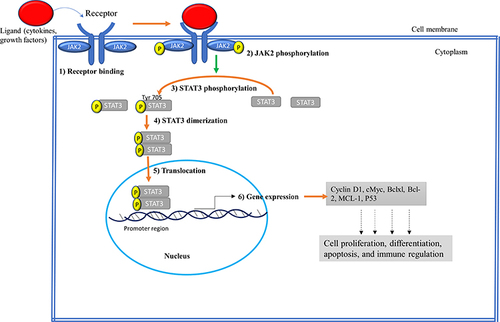Figures & data
Figure 1 Schematic diagram of JAK and STAT structures. (A) JAKs contain a FERM domain (400 amino acid residues) that associates with receptors, a SH2 domain (100 amino acid residues) that binds phosphorylated tyrosine residues, and a kinase (JH1) domain (250 amino acid residues) and pseudo kinase (JH2) domain (300 amino acid residues). The arrowhead pointed downward (JH1) indicates phosphorylation sites (tyrosine residues) needed for JAK activation. (B) STATs contain a CCD for dimerization, a DBD, a SH2 domain, and a TAD for transcriptional activation of target genes. The arrowhead pointed downward (TAD) indicates the conserved tyrosine residue required to be phosphorylated for STAT activation. N and C represents the amino- and carboxy-terminal ends respectively.

Figure 2 Schematic representation of the JAK2/STAT3 signaling pathway. (1) Receptor binding: Ligands such as cytokines and growth factors bind to extracellular domains of the receptors. (2) JAK2 phosphorylation: Following ligand binding receptor-associated JAK2 undergo phosphorylation to each other. (3) STAT3 phosphorylation: Activated JAK2 kinase domain (JH1) phosphorylates cytoplasmic tails of receptors, recruiting STAT3 to the receptor, and becomes phosphorylated at Tyr 705. (4) Dimerization: Phosphorylated STAT3 dimerizes at SH2 domain. (5) Translocation: Dimerized STAT3 translocates into the nucleus where it binds to the promoter region of DNA. (6) Gene Expression: Dimerized STAT3 acts as transcription factor and activates the transcription of target genes involved in regulating cell growth.

Table 1 Table Summary on the Role of JAK2/STAT3 Signaling Pathway in Tumorigenesis and Treatment of Different Solid Tumors
